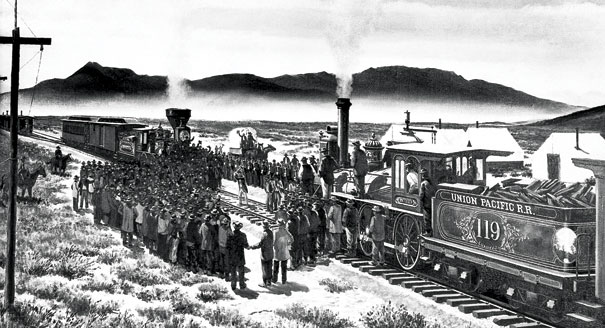
Americans had been enthusiastic railroaders long before the transcontinental line was built. In 1850, more than 9,000 miles of track covered the United States. By 1860, the number had risen to over 30,000 miles, more miles of rail than the rest of the world altogether. Initially, most of the construction had been in the nation’s growing industrial centers in the Northeast, but by 1860, railways were rapidly expanding into the upper Midwest.
Widget not in any sidebars
Congress began considering how best to support the building of a transcontinental line in the late 1840s. The discovery of gold in California in 1848 made the issue all the more urgent: only a transcontinental railway could effectively tie that far-off region to the rest of the nation. Northern and southern politicians, however, disagreed over where the line should be constructed, and the project stalled for more than a decade.
The outbreak of the Civil War finally broke the stalemate. Unencumbered by southern objections, northern legislatures approved a central route from Omaha, Nebraska, to Sacramento, California. More importantly, in 1862 and 1864 Congress passed acts that gave huge cash subsidies and land grants to private companies that agreed to build the tracks across the continent.
Recognizing a moneymaking opportunity, two companies took up the challenge. The California-based Central Pacific began laying tracks eastward from Sacramento. The eastern-based Union Pacific began in Omaha and built west. The laborers working for the Central Pacific faced the greater challenge-building across the rugged Sierra Nevada Mountains. As a result, their progress was naturally slower than that of the work force of the Union Pacific, who managed to average a mile a day over mostly flat terrain. The Central Pacific crew was primarily Chinese immigrants, while Irish immigrants dominated the Union Pacific. Toward the end of the project, the two sides engaged in a bitter rivalry that at times took on unpleasant racist overtones. Both groups, however, labored heroically in difficult and frequently dangerous conditions, often working as long as 15 hours each day.
When the two lines connected at Promontory in northern Utah, it was the beginning of a dramatic transformation of the West. A 3,000-mile journey that had previously taken months to complete could now take only days by rail. More importantly, the abundant resources of the West could be shipped quickly and profitably to insatiable eastern markets, greatly spurring the development of the western economy. In years to come, thousands of emigrants rode the rails westward to homestead land, encroaching on Native American territories and hastening the demise of their way of life. Perhaps more than any other single event, the completion of the transcontinental railroad enabled the American conquest and settlement of the West.





Be the first to comment